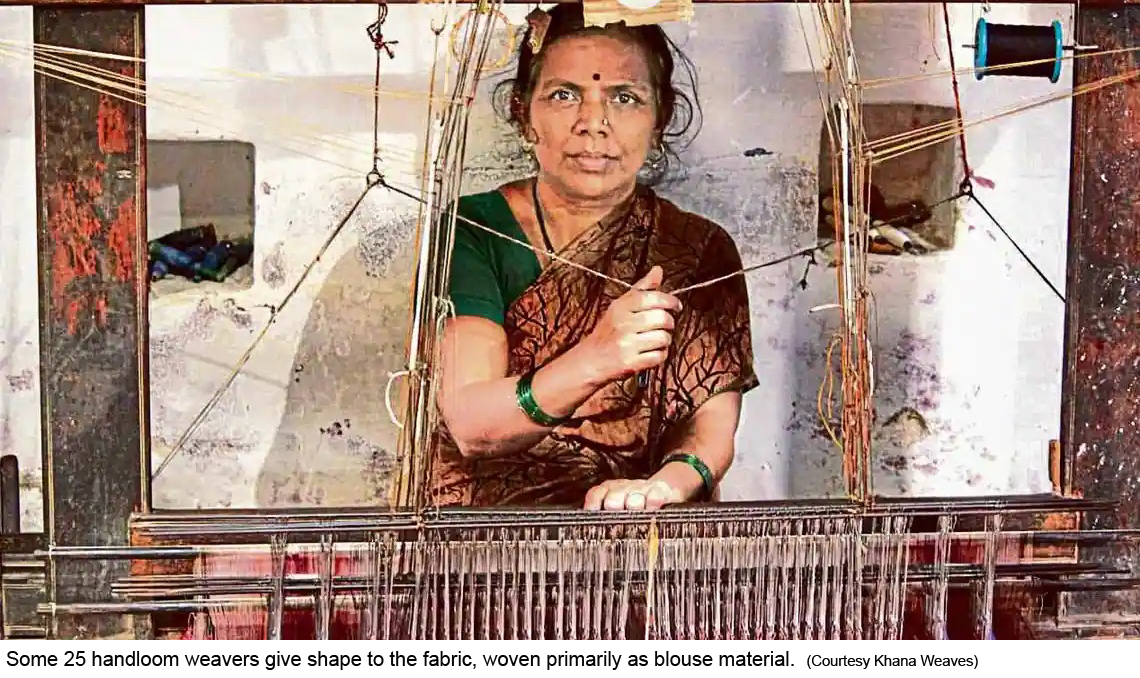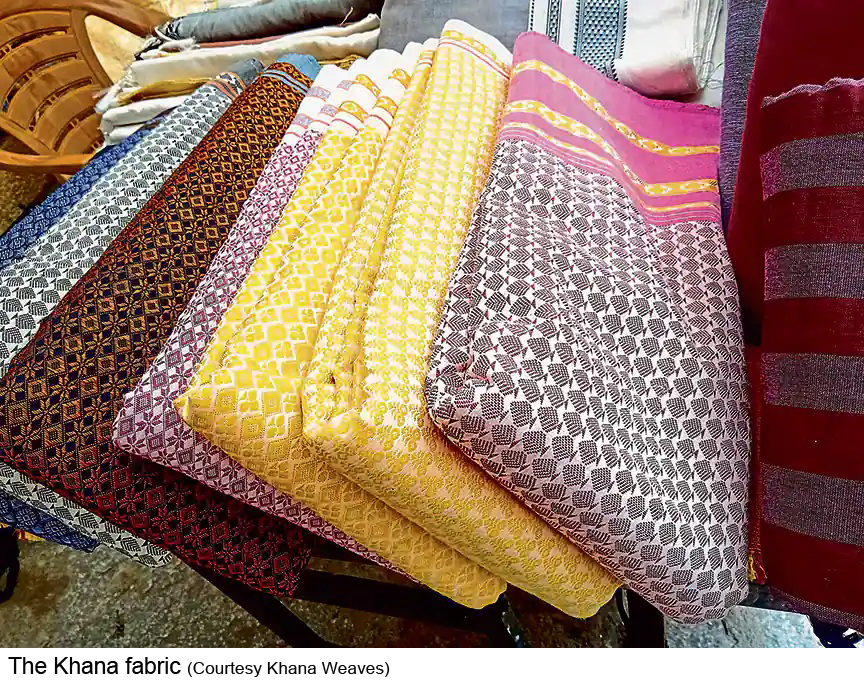
Category: INDIAN HERITAGE TEXTILE
Country: India
Using social media to reach customers directly, the weavers in Guledgudda hope to stitch a tale of survival
By Mahalakshmi Prabhakaran LAST PUBLISHED 05.06.2022 | 09:27 AM IST
It’s a lovely Sunday morning and Adappa Chinappa Alorli, 79, is pedalling away on his dobby loom, weaving Khana. “I have been weaving since I was 12 or 13. I continue to do it because it keeps me active,” Alorli says, sitting at his home in north Karnataka’s Guledgudda town. Around Holi last year, however, things were looking bad for the cluster of 25-odd handloom weavers, including Adappa.
Guledgudda is synonymous with Khana, or Khunn, fabric used for blouses but power looms had already taken a toll when the pandemic struck an almost fatal blow. Business came to a stop and the weavers were left with 1,000m of fabric (Khana blouse material and the Ilkal saris from the small town in the same, Bagalkot, district that traditionally accompany it). They weren’t keen on free food kits for a second year, determined to find some way of selling the fabric.

They approached Ramesh Ayodi, 27, a textile graduate from the Karnataka Handloom Technology Institute, Gadag, and a professional dyer who had moved to Guledgudda some months ahead of the pandemic, excited by the prospect of reviving the unique Khana. The weft is cotton, the warp is cotton, silk or rayon, and it’s interspersed with mathematically precise motifs inspired by nature, mythology and daily life. The material is always two-toned, which means the colour of the blouse border is in contrast to the body.
“Every year, the weavers weave Khana ahead of the wedding season in April. The pandemic happened before the wedding season, so they couldn’t sell anything in 2020, and the fact that it continued in 2021 made it worse,” Ayodi explains.
The small cluster of weavers decided to venture into uncharted territory to sell their fabric directly to customers. The first step was to come up with a brand name. Once that was decided—Khana Weaves— Ayodi roped in a few associates to help set up a website (www.khanaweaves.in) and Instagram handle (@khana_weaves). Messages were circulated on WhatsApp groups. The request was simple: “This year, the weavers don’t want to ask for donations. Instead, they are asking you to buy their cloth so it can afford them the dignity they are used to. If you would like to buy their products, please take a look at the catalogue.”
It worked spectacularly. Jahnavi Pai, a Bengaluru-based environmentalist who helped write the content for the campaign, says: “The website worked because once we put the story out on Twitter and other social media, word spread the world over. The website got 1,500 hits in a day.’”
“My mom had received a message about this campaign on a group she was on and she forwarded it along to me,” recalls Ranjitha Bhatt. The Hyderabad-based HR professional, a textile lover, ordered 20-30 Ilkal saris with Khana blouse material. “I did that because ordering just one or two pieces wouldn’t have made much of a contribution. I bought it in bulk with the idea that I would give some of these as gifts,” she says.
Within two months, Khana Weaves had sold its stock and raised ₹9.5 lakh. “I opened fixed deposits for each weaver,” Ayodi says. The weavers were relieved— and happy to get customer feedback. “It gave me a better idea of what my customer really wanted. I would like for customers to visit us because it will give them a better idea of the work that goes into making a piece of fabric. In turn, we get an idea of what customers really want,” Adappa says. Bengaluru designer and textile evangelist Prasad Bidapa is supportive. “The weaver got a better price and the customer paid less than what they would have as there was no middleman’s commission inflating the price. This must continue, for if the textile artisans of India connect to markets directly, it would create a new fashion ecosystem. This will enable them to grow their brands and be perceived as designers in their own right.”
This points to the larger challenge, one these weavers are hoping to take on. For while Guledgudda Khana fabric has a rich history—some reports trace it to the eighth century, others to the 16th century—and enjoys geographical indication protection, its survival continues to hang by a thread as it battles power looms and policies that hinder growth.
Before the pandemic, Khana had a big regional market, particularly in Maharashtra. This hasn’t revived, so far. “With covid-19 shutting down travel and inter-state trade, we have lost that market. It hasn’t picked up much pace this year,” Ayodi says.
In a story that is playing out across the country, most of the Khana weavers in Guledgudda fall in the 50-plus category. They grew up watching their elders spin magic, they know no other life. The process of making khana fabric is a lengthy one that needs at least five people. It includes steps like winding, dyeing, gumming, denting and weaving. Costs of raw material, be it dyes, cotton or silk, vary; 1m blouse material, for instance, is priced at around ₹500 currently, up from ₹350 a few months ago on the back of silk prices. Few youngsters are opting for the handloom work.
Can this change? Ayodi, who is now convener of Khana Weaves and has 18 of the 25 weavers working with him, believes one big limitation is the loom size: Since it’s meant for blouse material, the dimensions of the dobby loom are 32x56 inches (width x length). It cannot be used for anything else. The weavers work six-eight hours daily, weaving about 21m of fabric in three-four days to earn ₹1,200.
“We somehow have to save this,” Ayodi sighs. This year, Khana Weaves plans to take a leaf out of the book of designers and create accessories with khana under its own brand. Think kurtas, bags, cushion covers, bookmarks and notebooks bound in Khana fabric.
Some of the weavers are also planning to learn how to weave Ilkal saris. “The awareness of Khana continues to be low but there’s always a market for saris, so we shall weave them and funnel those funds into reviving khana,” says Ayodi. They may need to modify their existing looms or get new ones.
Mahalakshmi Prabhakaran is a Bengaluru-based journalist.
Courtesy: https://lifestyle.livemint.com/fashion/trends/how-weavers-are-using-instagram-to-save-khana-fabric-111654222304562.html
Copyrights © 2025 GLOBAL TEXTILE SOURCE. All rights reserved.